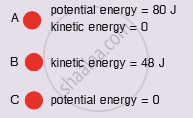Advertisements
Advertisements
प्रश्न
A ball of mass 0.20 kg is thrown vertically upwards with an initial velocity of 20 m s-1. Calculate the maximum potential energy it gains as it goes up.
उत्तर
Potential energy at the maximum height = initial kinetic energy
= `1/2` mv2
= `1/2×0.20 ×20 ×20`
= 40 J.
APPEARS IN
संबंधित प्रश्न
Show that the sum of kinetic energy and potential energy (i.e., total mechanical energy) is always conserved in the case of a freely falling body under gravity (with air resistance neglected) from a height h by finding it when
- The body is at the top.
- the body has fallen a distance x.
- the body has reached the ground.
A metal ball of mass 2 kg is allowed to fall freely from rest from a height of 5 m above the ground. Taking g = 10 m s-2, calculate:
- the potential energy possessed by the ball when it is initially at rest.
- the kinetic energy of the ball just before it hits the ground?
State whether the object possess kinetic energy, potential energy, or both :
A ceiling fan in the off position ______________
A boy weighing 40 kg makes a high jump of 1.5 m.
What is his potential energy at the highest point? (g = 10 m/s2)
What are the various forms of energy?
Water stored in a dam possesses :
How much electrical energy in joules does a 100 watt lamp consume : in 1 second?
Five electric fans of 120 watts each are used for 4 hours. Calculate the electrical energy consumed in kilowatt-hours.
Explain the transformation of energy in the following cases :
(i) A ball thrown upwards.
(ii) A stone dropped from the roof of a building.
A ball falls to the ground as shown below :
What is the kinetic energy of ball when it hits the ground?
